Ellen and Jim Have a Blog, Too
We are two part-time academics. Ellen teaches in the English department and Jim in the IT program at George Mason University.


Saturday: Stevenson's "The Price, a November letter & 3 _Persuasions_ · 17 November 07
Dear Anne,
I began last night to recover from Thursday, and now find myself in quietude and peace and enjoying a day at various kinds of work (student papers, studying movies, doing bills even). Though still tired, no longer so strained as Ann Firbank playing Anne Elliot after her long country walk attempting to refuse a ride in carriage offered to her by the Crofts:
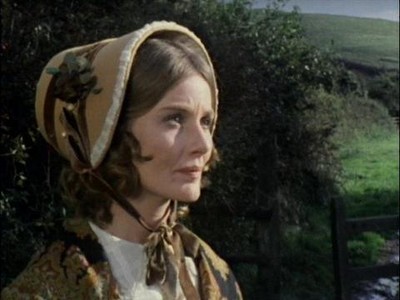
Today’s a beautiful sunny and cold early winter’s day: many variegated leaves are tenuously holding onto the trees as yet; one strong rain though will bring them all down. Later the Admiral and I will go for walk. A scene from the 1971 BBC Persuasion of a walk down a country lane in autumn:
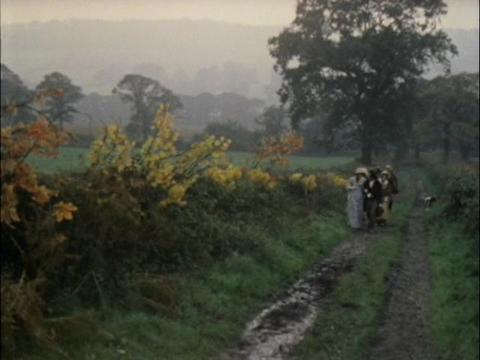
Someone told me this is very like Stevenson where Austen was born and lived as a girl; so here’s another still from this early film of Persuasion:
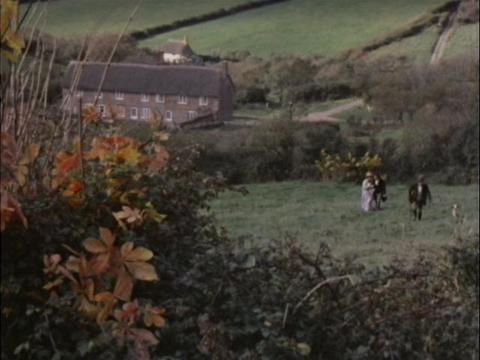
I thought I’d celebrate this recovery by sending you two more poems by Anne Stevenson as (as you already see) lovely stills from the 3 Persuasion films available to the public on DVD.
I have sent you a number by Stevenson already, including my favorite, “Re-reading Jane”. She recently won a very prestious prize for her poetry, the Lannan, which comes with a huge lump of money ($200,000? – is that possible), and she’ll soon be immortalized in a Library of American volume. I find much solace, understanding (and subdued pain), strength & beauty in her work.
First, a short lyric:
The Price
The fear of loneliness, the wish
to be alone;
love grown rank as seeding grass
in every room,
and anger at it raging at it,
storming it down.
Also that four-walled chrysalis
and impediment, home;
that lamp and hearth, that easy fit
of bed to bone;
those children, too, sharp witnesses
of all I’ve done.
My dear, the ropes that bind us
are safe to hold;
the walls that crush us
keep us from the cold.
I know the price, and still
I pay it, pay it:
Words, their furtive kiss,
illicit gold.
A longer lyric is a November letter from a novella in verse letters, Correspondences: A Family History in Letters. Stevenson’s verse novella is based on real people in her family about a century before her life. Excluding these memories of the past central to the work, the years covered literally by the letters written are 1930-1968. The story line also reflects incidents in her own & family’s lives. The characters are reasonably complex and interact, but the poems can also stand alone. The subtitle in this phase of the novel is “Women in Marriage.”
A London letter
The poet, Kay Boyd, replies ambiguously to her sister in Clearfield.
November 11, 1968
HAMPSTEAD, LONDON
Your letter arrived with its letters
lunging at my conscience.
Alone in wet London
with the wind trailing rain
around these ugly brick villas,
the four o’clock night
arriving with my late lunch,
I ask myself often
why it is impossible to go home?
Why is it impossible,
even here,
to be peaceful and ordinary?
The ordinary offers itself up,
Beaten, breathed in.
It counts on being dependable.
This is a window
This is an apple,
This is a girl.
And there is a cyclamen
blood climbingout of the ground
And there is a blind of rain.
And now between the girl
and the flower-flame on the window sill
the window is a blur of rainwater.
I wonder how she felt, Persephone,
when she bit for ever into the half-moon pomegranate?
Did she miss ordinary things?
She could have lived
without risking the real fruit.
There were only six seeds.
She willed to eat nothing else.
It was hunger.
Without nourishment how could she live?
Eating, she lived on through
winter after winter,
the long year perfected,
the cold, waking rain
raising a few seeds to green
from her creative darkness.
But the mother smiled and smiled.
She was brilliantly consumed, a sacrifice
sufficient for each summer.
Should any daughter blame her?
The mother made her choice.
She said her ‘no’ smiling.
She burned the kissed letters.
She spat out the aching seeds.
She chose to live in the light.
Would you wake her again from the ground
where at last she sleeps
plentifully?
From the 1995 BBC Persuasion, Amanda Root as Anne Elliot resting from the same walk in a cold November autumn landscape:
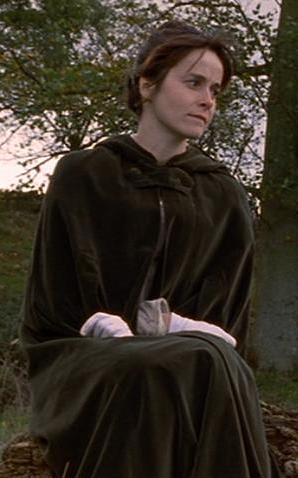
Near her paces her sister, Sophie Thompson as Mary Musgrove:
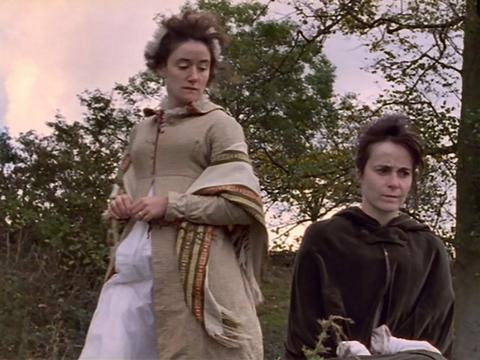
A little later in the 1995 BBC Persuasion with Wentworth nearby and apparently ignoring her, Anne desperately tries not to lose control by picking a twig out of her glove:
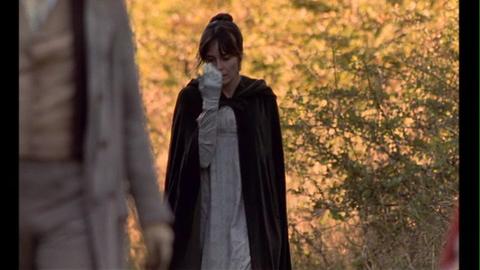
An equivalent scene in the 2007 ITV Persuasion, Sally Hawkins as Anne Elliot is concentrating very hard to hold to her sanity, but about to lose her balance:
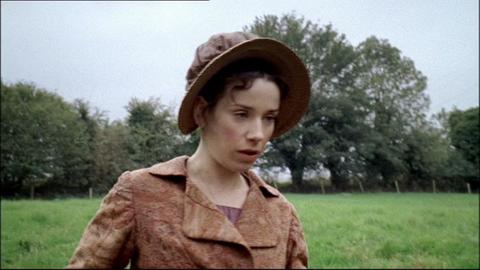
Rupert Penry-Jones as Captain Wentworth is right there to pick her up swiftly:
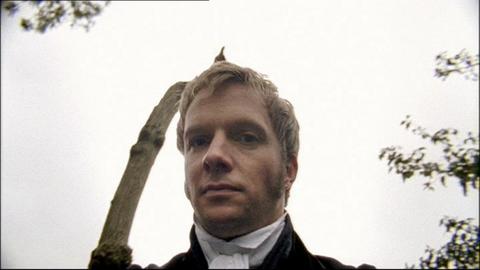
They make the first close direct eye-contact of the film:
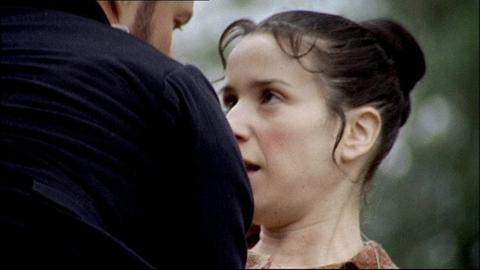
Then as Wentworth Penry-Jones stands near Anne, hesitating for a split second, but then Sam Hazeldine as Charles Musgrove comes over:
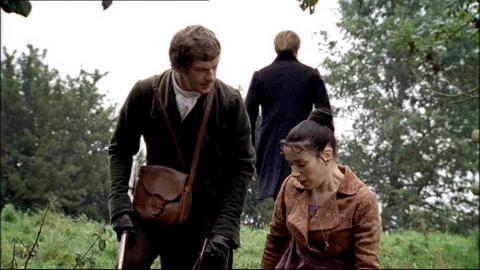
so the moment is lost, he turns back and walks away.
The older film has Ann Firbank reaching out to Rowland Davies as Charles Musgrove (Wentworth and Louisa Musgrove are in the rear):
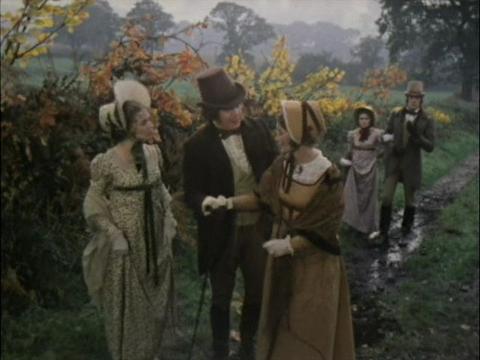
Amanda Root as Anne Elliot only stumbles in the 1995 film but still Ciarhan Hinds as Wentworth cannot bear to see her suffer so (more gently than Rupert Penry-Jones), Hinds comes over, takes up the space, and maneuvers Root onto the carriage, coming over:
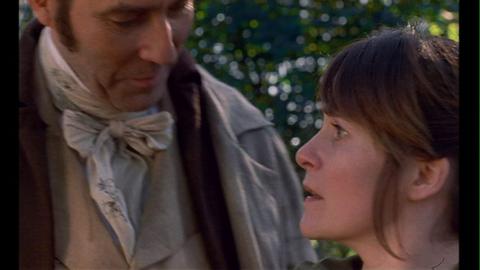
The first touch, a grasp, in the movie:
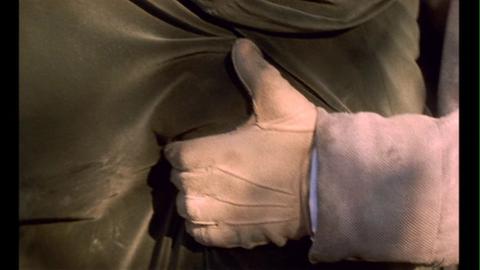
It’s the second one in the novel; in the first Wentworth frees Anne from harassing children.
She looks to him:
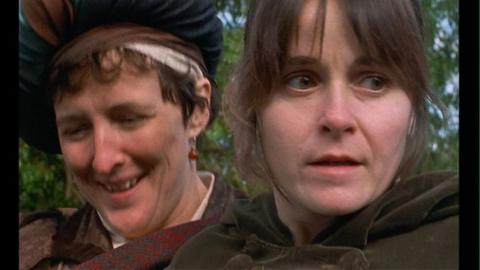
Hinds can bear it no more than Rupert Penry-Jones, and looks away:
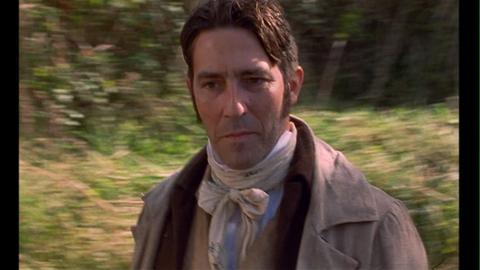
***********
I connected Stevenson’s poems with Austen’s Persuasion. Stevenson’s Persephone and Ceres are in as much pain as Austen’s Anne Elliot. Austen’s Mary Musgrove is an unkind sister to Anne who mothered her; Sophie Thompson conveys more: she conveys Mary’s sadness; Sophie’s Mary is an edgy near-desperate woman.
One of Stevenson’s finest poems is after all to Austen.
Sophie
P.S. In looking at the 3 Persuasion films I discovered that a lot more sheer landscape was offered in 1971; that there was an increase in uncontrolled emotional pain and loss of control each time. How much tamer is the 1971 film; how bold the 2007, but the 2007 switches the roles so Wentworth is strongly in control and the rescuer. The 1995 film is subtler, more delicate. None of these stills are well enough known. (Each time it was I in the carriage who offered Miss Elliot a seat, and in the 1995 film you see Fiona Shaw as Mrs Sophie Crofts, Wentworth’s sister.)
--
Posted by: Ellen
* * *
Comment
- Another poem by Stevenson:
Her “Painting It In” comes from a series in her Poems 1955-2005
called “The Art of Making.” It appears just after some poems to other poets, earlier writers (the one to Jane Austen), and
poems on paintings:
“Painting It In”
Wake up at six o’clock. We’re out to sea.
Nothing beyond that fence and slatted gate
but a grey wave and plume-like shapes that could be
flaws in the canvas or unmixed pigment in paint.
Stones, blurred poppies, a wheelbarrow full of grass
affirm a foreground. The world must exist out there.
People must be getting up and getting washed,
putting the kettle on, picking up a newspaper.
Somewhere it must matter terribly not to be late,
not to miss the limousine to the airport,
not to be missed when the finance committee votes;
when the training course commences, not be left out.
But somewhere is hard to believe when it’s not invented,
when the world blindly refuses to admit detail.
All that’s required is pastoral: sheep among stunted
rowans; for background, eroded ‘Moelfre’ or ‘bald hill’.
The thing’s been done so many times. Imagine
brushing the lichen’s pale quartz over the rocks,
now the shocking pink foxgloves, painting them in,
old-fashioned belles de joie, drunk on their stalks.
What if today decides never to take off its veil,
never to palliate art with a grand show
of perspectives up the valley? More likely all we’ll
get is light’s first lesson, an application of gesso,
a white out of air – sweet, soft, indestructible,
the cloud of unknowing reluctant to create the known.
Hills, stones, sheep, trees are, as yet, impossible.
And when things are unmade, being also feels less alone.
E.M.
— Elinor Nov 18, 5:50pm # - “Ellen:
As a matter of interest, this (attached) picture looks exactly like the walk from Jane’s home-of-her-youth in Steventon up the slope to the church where her father preached. The house would have been roughly in the centre of the picture, at the far end of the field, with its back to us. The church would be behind the photographer’s right shoulder.
If you have visited Steventon, perhaps you will see what I mean.
With good wishes,
Ivan”
— Elinor Nov 19, 1:16pm # - “Dear Ellen,
I have always wanted to tell you that I appreciate your insights and your scholarship. We all benefit from you generosity as you patiently share it with the Austen list serve.
You have motivated me to rewatch the early PBS versions of the JA novels. I have always been a big fan of the Emma adaptation. We are NetFlixers, so I am patiently waiting for the films to get to the top of my queue. When I go to your blog, following the link from the list, I can never find the stills that you post. Do you have any guidance for me?
I tried searching, but that is not doing it. I might not be seeing the whole entry, but the current piece that I see has no links to stills. I rarely see any. I would appreciate any help.
Have a lovely thanksgiving. Keren”
— Elinor Nov 20, 5:46pm # - Dear Keren,
I very much appreciate your thanks. Around this time of year I sometimes feel alone, and it’s good to know that I am reaching others who love the same things I do.
I don’t know why you are not seeing the stills. As far as I can tell, most people do reach them. For example, the stills from Persuasion led one man to say the place photographed was like Steventon.
I can offer this: I have two blog galleries where I store the stills in chronological order and then transfer them to the blog.
Here are the galleries:
http://www.jimandellen.org/ellen/bloggallery2.html
http://www.jimandellen.org/ellen/bloggallery.html
While I don’t always date the entry of the pictures, I do include the title of the blog to which the pictures are transferred.
I hope you can see these. I have many stills from the Austen movies in these galleries.
— Elinor Nov 21, 11:21am # - “Dear Ellen,
Well this worked very well for me. I have been entranced all day, in between my financial analysis work. A little schizophrenic, but that is fine.
I initially felt silly writing to you now, but I am so glad I did. Don’t feel alone, you truly are a light to many. You see so much beauty in the world, take heart in the peace that you reflect. Thank you again and happy holiday,
Keren”
— Elinor Nov 21, 7:24pm # - Thank you. I do try to take heart.
A joke: I'm made to feel that tomorrow I shall be surrounded by groups of biologically-related people sitting around eating specially-engineered big birds :)
Cheers,
E.M.
— Elinor Nov 22, 12:54am #
commenting closed for this article
